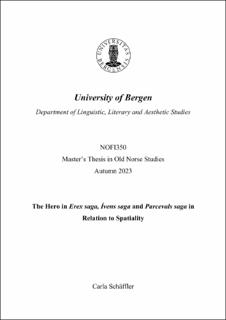| dc.description.abstract | This Master’s thesis, by the title “The Hero in Erex saga, Ívens saga and Parcevals saga in Relation to Spatiality” written by Carla Schäffler, analyses these three sagas in context of spatiality and its relation to the literary depiction of the male protagonists’ masculinity. The sagas are part of the Old Norse literary genre of translated riddarasögur. Originally, the texts are based on Old French verse novels that were translated into Old Norse during the reign of King Hákon Hákonarson (1204–1263) to serve his political agenda to establish a hierarchical society in Norway by implementing the norms and values portrayed in the sagas on his courtiers in order to create a standardised society across his kingdom and to thereby also make his kingdom competitive with the rest of continental Europe, as the standards of the Norwegian court were lacking compared to the rest of Europe. The analysis of this thesis mainly focuses on the three saga’s relation of spatiality and the hero’s masculinity, but also shows how his masculinity is intertwined with the code of conduct displayed in the translated riddarasögur, the Konungs skuggsjá (composed around 1250) and Hirðskrá (compiled between 1273 and 1277). The two latter texts are Old Norse courtly texts, with the first-mentioned being a didactic work, whereas the other represents a code of law for the king’s retainers. In order to conduct this analysis, the spaces within the sagas are categorised into the space of the court, the forest space, the space of the other court and the magical space, through which the hero’s movement and his changing courtly masculinity is analysed. The results show how each space is semantically charged and that the spaces are necessary to portray the hero’s unfulfilled masculinity through a lack of a courtly value, but also to help him repair and regain his masculinity in retrieving the lost value through his movement within the different spaces which create plot and thereby quests for the knight. The spaces and the subsequent quests that result from the hero’s movement within them also reveal the core value that each saga aims to portray. In the case of Erex saga and Ívens saga, it is the refined value of honour. For Parcevals saga, which describes the full education of the hero it not only includes the refined facets of courtly masculinity, but also portrays the even more basic values and norms presented by Konungs skuggsjá in the form of the virtues manvit [wisdom], the basis of all good manners, siðgǿði [good breeding] and hǿverska [courtesy], which represent the refined form of courtliness. | |
